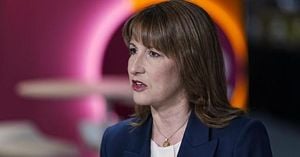A fierce debate is raging in the United Kingdom over the future of guidance for transgender people’s access to single-sex spaces, with the government, equality watchdogs, and European human rights officials all locked in a high-stakes standoff. At the heart of the matter lies an updated code of practice, drafted by the Equality and Human Rights Commission (EHRC), which has been awaiting government approval for more than six weeks, following a landmark Supreme Court ruling in April 2025 that redefined the legal meaning of ‘woman’ and ‘sex’ as biological categories under the Equality Act 2010.
The Supreme Court’s decision, which clarified that the words “woman” and “sex” in the Equality Act refer strictly to biological sex, set off a wave of legal and social repercussions. According to The Times, the EHRC moved quickly to draft new guidance for organizations ranging from hospitals to sports clubs and gyms, aiming to ensure that rules for single-sex spaces aligned with the updated legal definition. The code, running over 300 pages, was formally submitted to Women and Equalities Minister Bridget Phillipson on September 4, 2025, but has since been mired in political delays and controversy.
On October 15, Baroness Kishwer Falkner, chairwoman of the EHRC, publicly called on the government to “act at speed” and approve the new code. “The updated code ought to be brought into force as soon as possible. How quickly this happens is now in the Government's hands. We urge them to act at speed,” she told the House of Lords, as reported by the BBC. Baroness Falkner’s urgency was echoed in a letter to Phillipson, in which she warned that the old 2011 code is now unlawful and that some organizations are continuing to use it, risking practices that are inconsistent with the law. “The practical implications of this are that the 2011 code is now unlawful and will continue to be so until the minister makes an order to withdraw it,” she wrote, emphasizing the need to revoke the outdated code “as soon as possible now that Parliament has returned, so that courts, tribunals and duty bearers are clear that it is no longer to be relied on.”
The government, for its part, has cited the sheer length and complexity of the proposed code as justification for the delay. A spokesperson told The Guardian, “The Government is considering the draft updated code and, if the decision is taken to approve it, the minister will lay it before Parliament. The proposed code of practice is over 300 pages long, so it is important that the correct process is followed.” The process, once initiated, would require the code to be laid before Parliament for 40 days before coming into force.
However, the standoff has taken on a distinctly political flavor. Critics, including opposition politicians and women’s rights groups, have accused Minister Phillipson of dragging her feet to avoid alienating Labour backbenchers and jeopardizing her bid for the deputy leadership. Claire Coutinho, Tory shadow equalities minister, argued, “It is unforgivable for the minister to put her own political ambitions above the safety and dignity of women… The longer she takes to deliver guidance, the more she is failing to protect the rights of women and girls to single-sex spaces and services.” According to The Daily Mail, some believe that internal party politics are playing an outsized role in the delay, though Phillipson has denied these allegations.
The EHRC, meanwhile, insists it has provided the government with all requested materials, including an equality impact assessment delivered on October 13, and has offered further discussions to expedite the process. “We were asked to provide the equality impact assessment last Friday, we provided it to the Government on Monday. We’re here to serve the Government with any information that it needs at pace,” Baroness Falkner told peers, as reported by The Telegraph.
Women’s rights advocates have expressed growing concern that the delay in implementing the new guidance could be harming women’s safety and dignity. Maya Forstater, chief executive of Sex Matters, said, “The law has been clear for six months. The reluctance to comply with the law is shameful, and it harms everyone, particularly women who find themselves sharing female-only spaces and services with men claiming to be women.” According to The Guardian, the EHRC’s draft code includes provisions allowing sports clubs or hospitals to request a birth certificate if there is “genuine concern” about a person’s biological sex, and permits the exclusion of transgender people from competitive sport when necessary for safety or fair competition.
On the other side of the debate, transgender rights campaigners have criticized the EHRC’s approach, warning that the new guidance could foster a climate of fear and exclusion. The Good Law Project, which is pursuing legal action over earlier EHRC guidance, argued that some trans people had been “afraid to go out because of the climate of fear” created by interim advice released after the Supreme Court ruling. Jo Maugham, executive director of the group, asked, “If the High Court finds the Guidance unlawful, will you apologise to those whose lives you have so profoundly harmed?”
The controversy has not gone unnoticed in Europe. In early October, Michael O’Flaherty, the Council of Europe’s human-rights commissioner, sent a letter to UK parliamentary committee chairs and the Home Secretary, warning that the treatment of transgender people in the UK must comply with the European Convention on Human Rights (ECHR). O’Flaherty cautioned against leaving transgender people in an “intermediate zone” following the Supreme Court’s ruling, and stressed the importance of ensuring that new guidance is clear on “how inclusion of trans people can be achieved across all areas, and how exclusion can be minimised to situations in which this would be strictly necessary and proportionate.”
O’Flaherty’s intervention has sparked a debate over national sovereignty and the role of international bodies in shaping domestic policy. As reported by spiked, some British commentators have called for the UK to leave the ECHR altogether, arguing that decisions about women’s rights, anti-Semitism, and free speech should be made by the British people, not unelected officials in Strasbourg. The article contends that O’Flaherty’s advocacy for replacing biological sex with gender identity in law undermines women’s rights and safety, and that the British government, not foreign bodies, should decide on such sensitive matters.
Downing Street, attempting to strike a balance, reaffirmed on October 16 that “there are laws in place to protect trans people from discrimination and harassment and we proudly uphold a robust legislative framework.” Yet the government has also criticized the Council of Europe’s involvement, with sources close to Home Secretary Shabana Mahmood stating that O’Flaherty’s intervention was “supremely unhelpful” to those attempting to maintain public confidence in the ECHR while managing domestic reforms.
As the debate continues, organizations across the UK remain in limbo, unsure which guidance to follow and how to navigate the fraught terrain of single-sex spaces. The outcome of this standoff—between government, equality watchdogs, campaigners, and European officials—will have far-reaching consequences for the rights and safety of both women and transgender people in Britain. For now, the country waits, watching to see who will blink first in a contest that has become about far more than just bathrooms and changing rooms.




